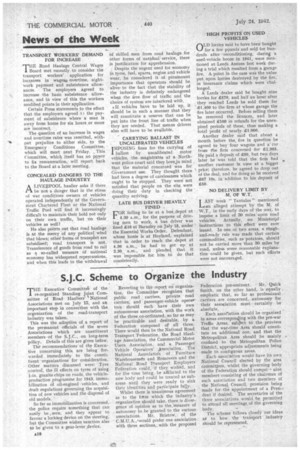S.J.C. Scheme to Organize the Industry
Page 20

If you've noticed an error in this article please click here to report it so we can fix it.
THE Executive Committee of the re-organized Standing Joint Cornmittee of Road Hauliers' National Associations met on July 15, and at important step in connection with the organization of the road-transport industry was taken.
This was the adoption of a report of the permanent officials of the seven Associations which are constituent members of the S.J.C., -on long-term policy. Details of this are given below.
The recommendations of the Executive concerning this are being forwarded immediately to the constituent • organizations for consideration. Other matters discussed were: Tyre control, the ill effects on tyres of using I-in, granite chips on roads, the vehicleproduction programme for 1943, immobilization of oil-engined vehicles, and draft regulations governing the acquisition of new vehicles and the disposal of old models.
So far as immobilization is concerned, the police require something that can easily be , seen, and they appear to favour a lockieig device on the steering, but the Committee wishes sanction also to be given -to a gear-lever ,device.
Reverting to the report on organization, the Committee recognizes that public road carriers, private road carriers, and passenger-vehicle opera tors should each have their own autonomous association, with the work of the three co-ordinated, so far as may he practicable and desirable, by a Federation composed of all three. There would then be the National Road Transport 'Federation, the Road Haulage Association, the Commercial Motor Users Association, and a Passenger Vehicle Operators' Association. The National Association of. Furniture N•Varehousernen and Removers and the National Road Transport Employers Federation could, -if they wished, and for the time being, be affiliated to the new body and could be treated as subareas until they were ready to sink their identities and participate fully.
Whilst there is unanimous agreement as to the form which the industry's organization should take, there is divergence of opinion as to the;measure of autonomy to .be granted to the various associations. Mr. Bristow, of the C.M.U.A.,4would prefer one association with three sections,. with the proposed
Federation pre-eminent. Mr. Quick Smith, on the other hand, is equally emphatic that, so far as professional carriers are concerned, autonomy for their association. must certainly be absolute. .
Each association should be organized in areas corresponding with the pre-war Traffic Areas, subject td the provisos that the war-time Area should constitute an additional one, and that the Metropolitan Area should be mainly . confined to the Metropolitan Police District, appropriate adjustments being made to contiguous areas.
Each association would have its own National Council elected by the area committees, whilst the governing body of the Federation should compri— nine members consisting of the chairman of each association and two members of the National Council, provision being made for the appointment of a Presi-, dent if desired. The secretaries of the three associations would be permitted to attend all meetings. of the governing body.
The scheme follows closely our ideas ae to how the transport industry should be represented.




















































